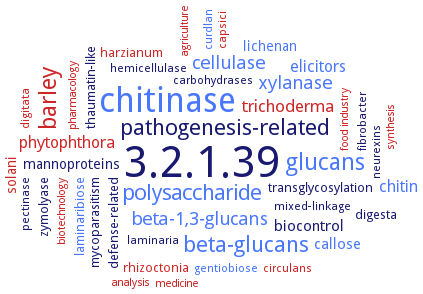3.2.1.39: glucan endo-1,3-beta-D-glucosidase
This is an abbreviated version!
For detailed information about glucan endo-1,3-beta-D-glucosidase, go to the full flat file.

Word Map on EC 3.2.1.39 
-
3.2.1.39
-
chitinase
-
glucans
-
barley
-
beta-glucans
-
pathogenesis-related
-
polysaccharide
-
cellulase
-
beta-1,3-glucans
-
xylanase
-
trichoderma
-
elicitors
-
chitin
-
phytophthora
-
biocontrol
-
callose
-
lichenan
-
solani
-
mannoproteins
-
rhizoctonia
-
transglycosylation
-
defense-related
-
thaumatin-like
-
zymolyase
-
digesta
-
mycoparasitism
-
harzianum
-
laminaribiose
-
mixed-linkage
-
circulans
-
capsici
-
hemicellulase
-
fibrobacter
-
gentiobiose
-
curdlan
-
digitata
-
carbohydrases
-
laminaria
-
pectinase
-
neurexins
-
pharmacology
-
medicine
-
synthesis
-
food industry
-
biotechnology
-
agriculture
-
analysis
- 3.2.1.39
- chitinase
- glucans
- barley
- beta-glucans
-
pathogenesis-related
- polysaccharide
- cellulase
- beta-1,3-glucans
- xylanase
- trichoderma
- elicitors
- chitin
- phytophthora
-
biocontrol
- callose
- lichenan
- solani
-
mannoproteins
- rhizoctonia
-
transglycosylation
-
defense-related
-
thaumatin-like
-
zymolyase
-
digesta
-
mycoparasitism
- harzianum
- laminaribiose
-
mixed-linkage
- circulans
- capsici
-
hemicellulase
-
fibrobacter
- gentiobiose
- curdlan
- digitata
-
carbohydrases
-
laminaria
- pectinase
-
neurexins
- pharmacology
- medicine
- synthesis
- food industry
- biotechnology
- agriculture
- analysis
Reaction
Synonyms
(1-3)-beta-D-glucan endohydrolase, (1-3)-beta-D-glucanase, (1-3)-beta-glucanase GI, (1->3)-beta-glucan endohydrolase, (1->3)-beta-glucan endohydrolase BGN13.1, (1->3)-beta-glucan endohydrolase GI, (1->3)-beta-glucan endohydrolase GII, (1->3)-beta-glucan endohydrolase GIII, (1->3)-beta-glucan endohydrolase GIV, (1->3)-beta-glucan endohydrolase GV, (1->3)-beta-glucan endohydrolase GVI, (1->3)-beta-glucanase, (1->3)-beta-glucanase A1, (1->3)-beta-glucanase BGN13.1, (1->3)-beta-glucanase isoenzyme GI, (1->3)-beta-glucanase isoenzyme GII, (1->3)-beta-glucanase isoenzyme GIII, (1->3)-beta-glucanase isoenzyme GIV, (1->3)-beta-glucanase isoenzyme GV, (1->3)-beta-glucanase isoenzyme GVI, (13)-beta-glucan 3-glucanohydrolase, (13)-beta-glucan endohydrolase, 1,3-beta-D-glucanase, 1,3-beta-glucan 3-glucanohydrolase, 1,3-beta-glucan hydrolase, 1,3-beta-glucanase, 1,3-beta-glucanase I, Acidic beta-1,3-glucanase, acidic endo-beta-1,3-glucanase, AkLam36, Anther-specific protein A6, Ban-Gluc, Basic beta-1,3-endoglucanase BGN13.1, Basic beta-1,3-glucanase, beta-(1-3)-glucanase, beta-1,3 glucanase, beta-1,3-D-glucanase, beta-1,3-endoglucanase, Beta-1,3-endoglucanase GI, Beta-1,3-endoglucanase GII, Beta-1,3-endoglucanase GIII, Beta-1,3-endoglucanase GIV, Beta-1,3-endoglucanase GV, Beta-1,3-endoglucanase GVI, Beta-1,3-endoglucanase, basic, beta-1,3-glucan hydrolase, beta-1,3-glucanase, beta-1,3-glucanase I, beta-1,3-glucanase II, beta-glucanase, Bgl, Bgl2, Bgl64A, BglF, BglII, BglS27, Bglu50A, Bgt17AE158A, CaENG, callase, CC1G_04051, CcGluE, Cel17A, DEHA2G18766g, DEHA2G18766p, EGase1, EGase2, EGase3, endo-(1,3)-beta-D-glucanase, endo-(1-3)-beta-glucanase, endo-(13)-beta-D-glucanase, endo-1,3-beta-D-glucanase, endo-1,3-beta-glucanase, endo-1,3-beta-glucosidase, endo-1,3-glucanase, endo-1,3;4-beta-glucanase, endo-beta-1,3(4)-glucanase, endo-beta-1,3-D-glucanase, endo-beta-1,3-glucanase, endo-beta-1->3-glucanase, endo-type beta-1,3-glucanase, Endo23, Eng, eng1, ENG16A, Eng2, Eng2 protein, EngA, Engl1, exo-beta-1,3-glucanase, Fra e 9.01 allergen, Gbl2a, Gbl2b, Gbl2c, Gbl2d, Gbl2e, Gbl2f, Gbl3, Gfa, GH family 81 beta-1,3-glucanase, GLU, Glu1, GluA, GLUB20-2, glucan endo-1,3-beta-glucosidase, Glucanase GLA, Glucanase GLB, glucanase LIV, glucanase Lo, GLUD2, HdLam33, kitalase, LAM, Lam81A, LamA, laminaranase, laminarinase, Lic16A, lytic beta-(1-3)-glucanase I, lytic beta-(1-3)-glucanase II, Mo enzyme, More, oligo-1,3-glucosidase, OsGlu1, OsGlu2, PCEng2p, PfLamA, PpGns1, PR-2B, PR-35, PR-36, PR-37, Rv0315, SLam, SpsLamIV, TLam, TmLam, VIT_05s0077g01150, VIT_205s0077g01150, VIT_206s0061g00120, VIT_208s0007g06060, YlCrh1Sp, YlCrh2Sp, zerzaust, ZET, ZgLamA


 results (
results ( results (
results ( top
top





